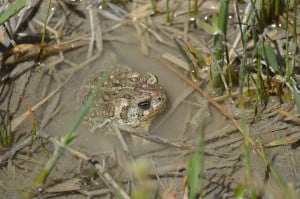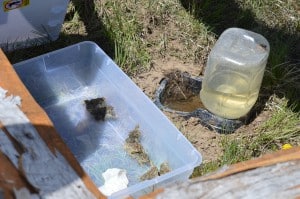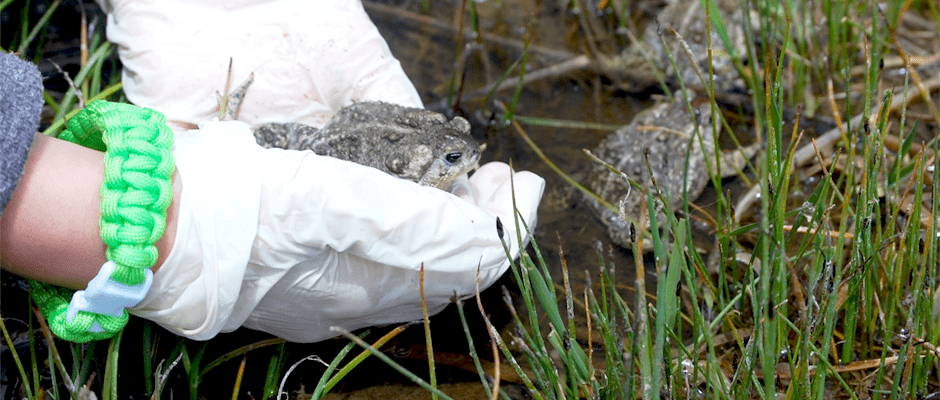Share this article
Hundreds of endangered toads released in Wyoming
On June 1, 900 captive-bred Wyoming toads (Anaxyrus baxteri) hopped into the wild at three sites along Wyoming’s Little Laramie River, marking the largest-ever release of adult amphibians by the National Fish Hatchery System, according to Steve Segin, a public affairs specialist with the U.S. Fish and Wildlife Service. Biologists have been releasing Wyoming toad tadpoles and juvenile “toadlets” yearly since 1995, but so far the juveniles have failed to generate any self-sustaining wild populations. This time, managers released adult toads in hopes that the larger, more robust animals would have a better chance at survival.

Wyoming toads are thought to be one of the four most endangered amphibians in North America. ©Robert Mansheim
“This was the first-ever large scale release of adult toads, and it will hopefully overcome some of the issues that we’ve been having with overwinter survival in the wild,” said Douglas Keinath, recovery coordinator for the Wyoming Ecological Services Field Office of the USFWS.
Wyoming toads were once common within their small range in Wyoming’s Albany County, but their population plummeted in the 1970s. The primary culprit is thought to be chytridiomycosis, the disease caused by chytrid fungus (Batrachochytrium dendrobatidis), which has decimated many amphibian populations worldwide. Other potential threats include habitat alteration and pesticides. By the time the USFWS listed Wyoming toads as endangered in 1984, the species already appeared to be extinct. A single population was rediscovered at Mortenson Lake in Albany County in 1987, but this population dwindled over the next few years, according to a 2006 paper published in the journal Bioscience. Eventually managers took the last of the amphibians out of the wild in an attempt to save the species.
Between 1995 and 2013, biologists released more than 188,000 captive-bred tadpoles and toadlets, according to USFWS’ revised recovery plan published in 2015. But few of these juveniles survived to breed.
“We were releasing very small and not very robust toads,” Keinath said. “We think that they would come out of the first winter already stressed. And then chytrid fungus would hit them right away, and that would do them in.”
Managers have learned how to generate tadpoles en masse, but until recently they lacked the resources to raise many to adulthood, says Keinath. The toads have large appetites, and caretakers must vary the creatures’ diets to ensure they can recognize food in the wild. Now, wildlife professionals are finally able to invest this kind of effort on a large scale, thanks to a Cooperative Recovery Initiative grant from the USFWS that has funded a new toad-rearing facility at the Saratoga National Fish Hatchery. The facility can house hundreds of toads at a time, nurturing them through the year it takes to grow from tadpole to adult, says Keinath. The 900 toads released this month were the first to be raised there.

Researchers placed some of the captive-reared toads in protected outdoor enclosures for three days, giving them a chance to acclimate to their new environment in safety. ©Robert Mansheimz
A similar, though smaller-scale, toad-rearing project is underway at Cheyenne Mountain Zoo in Colorado Springs, says Heidi Meador, a biologist who manages the toads at the Saratoga National Fish Hatchery.
Researchers are still working out the best way to introduce Wyoming toads to the wild. Some of the 900 toads were dropped straight into their new habitat, a process known as a hard release. Others had a gentler introduction, spending three days in outdoor enclosures protected from predators. Ideally, says Keinath, this “soft release” will give the toads a head start by letting them acclimate to their new environments in safety. The researchers will assess whether the soft release helped as they monitor the population, identifying individuals by their implanted microchips.
“We’re really hoping that this influx of adult healthy toads will spur some breeding out there,” Keinath said. “We want to get persistent populations on the ground in perpetuity.”
Header Image: Biologists release endangered Wyoming toads near Wyoming’s Little Laramie River.” Credit: “USFWS - Partners for Fish & Wildlife








